From Early Contraction to Post-Folding Fluid Evolution in the Frontal Part of the Bóixols Thrust Sheet (Southern Pyrenees) as Revealed by the Texture and Geochemistry of Calcite Cements
Abstract
:1. Introduction
2. Geological Setting
2.1. Lithology and Petrography
2.2. The Coll de Nargó Syncline
3. Methods
3.1. Petrography
3.2. Carbon and Oxygen Isotopes
3.3. Clumped Isotope Thermometry
3.4. Strontium Isotopes
3.5. Elemental Composition
4. Results
4.1. Fracture Sets and Calcite Cements
4.1.1. Fracture Set 1 (F1): ENE-WSW Reverse Faults and Related Calcite Cement Cc1
4.1.2. Fracture Set 2 (F2): NW-SE Fractures
4.1.3. Fracture Set 3 (F3): NW-SE and NE-SW Conjugate Fractures and Related Calcite Cements Cc1 and Cc2
4.1.4. Fracture Set 4 (F4): NE-SW and NW-SE Conjugate Fractures and Related Calcite Cements Cc3 and Cc4
4.1.5. Fracture Set 5 (F5): NW-SE and NE-SW Conjugate Strike-Slip Faults Filled with Calcite Cement Cc4
4.2. Oxygen and Carbon Isotopes
4.3. Clumped Isotopes
4.4. Strontium Isotopes
4.5. Elemental Composition
5. Discussion
5.1. Host Rock Diagenesis
5.2. Validity of Clumped Isotope Thermometry
5.3. Fluid-Flow Model: Fracture Development and Related Migrating Fluids
5.3.1. Early Contraction Stage (T1)
5.3.2. Main Folding Stage (T2)
5.3.3. Early Post-Folding Stage (T3)
5.3.4. Post-Folding Stage (T4)
6. Conclusions
Supplementary Materials
Author Contributions
Funding
Acknowledgments
Conflicts of Interest
References
- Fyfe, W.S.; Price, N.J.; Thompson, A.B. Fluids in the Earth’s Crust: Their Significance in Metamorphic, Tectonic, and Chemical Transport Processes; Elsevier Scientific Pub. Co.: Amsterdam, The Netherlands, 1978; ISBN 9780444601483. [Google Scholar]
- Ferry, J.M.; Dipple, G.M. Fluid flow, mineral reactions, and metasomatism. Geology 1991, 19, 211. [Google Scholar] [CrossRef]
- Deming, D. Fluid flow and heat transport in the upper continental crust. Geol. Soc. Lond. Spec. Publ. 1994, 78, 27–42. [Google Scholar] [CrossRef]
- Garven, G. A hydrogeologic model for the formation of the giant oil sands deposits of the Western Canada sedimentary basin. Am. J. Sci. 1989, 289, 105–166. [Google Scholar] [CrossRef]
- Duddy, I.R.; Green, P.F.; Bray, R.J.; Hegarty, K.A. Recognition of the thermal effects of fluid flow in sedimentary basins. Geol. Soc. Lond. Spec. Publ. 1994, 78, 325–345. [Google Scholar] [CrossRef] [Green Version]
- Putnis, A. Mineral replacement reactions: From macroscopic observations to microscopic mechanisms. Mineral. Mag. 2002, 66, 689–708. [Google Scholar] [CrossRef]
- Trincal, V.; Lanari, P.; Buatier, M.; Lacroix, B.; Charpentier, D.; Labaume, P.; Muñoz, M. Temperature micro-mapping in oscillatory-zoned chlorite: Application to study of a green-schist facies fault zone in the Pyrenean Axial Zone (Spain). Am. Mineral. 2015, 100, 2468–2483. [Google Scholar] [CrossRef]
- Gasparrini, M.; Ruggieri, G.; Brogi, A. Diagenesis versus hydrothermalism and fluid-rock interaction within the Tuscan Nappe of the Monte Amiata CO2-rich geothermal area (Italy). Geofluids 2013, 13, 159–179. [Google Scholar] [CrossRef]
- Sibson, R.H. Fault rocks and fault mechanisms. J. Geol. Soc. Lond. 1977, 133, 191–213. [Google Scholar] [CrossRef]
- Sibson, R.; Scott, J. Stress/fault controls on the containment and release of overpressured fluids: Examples from gold-quartz vein systems in Juneau, Alaska; Victoria, Australia and Otago, New Zealand. Ore Geol. Rev. 1998, 13, 293–306. [Google Scholar] [CrossRef]
- Aydin, A. Fractures, faults, and hydrocarbon entrapment, migration and flow. Mar. Pet. Geol. 2000, 17, 797–814. [Google Scholar] [CrossRef]
- Van Noten, K.; Muchez, P.; Sintubin, M. Stress-state evolution of the brittle upper crust during compressional tectonic inversion as defined by successive quartz vein types (High-Ardenne slate belt, Germany). J. Geol. Soc. Lond. 2011, 168, 407–422. [Google Scholar] [CrossRef] [Green Version]
- Knipe, R.J.; McCaig, A.M. Microstructural and microchemical consequences of fluid flow in deforming rocks. Geol. Soc. Lond. Spec. Publ. 1994. [Google Scholar] [CrossRef]
- Ogata, K.; Senger, K.; Braathen, A.; Tveranger, J. Fracture corridors as seal-bypass systems in siliciclastic reservoir-cap rock successions: Field-based insights from the Jurassic Entrada Formation (SE Utah, USA). J. Struct. Geol. 2014, 66, 162–187. [Google Scholar] [CrossRef]
- Travé, A.; Labaume, P.; Vergés, J. Fluid Systems in Foreland Fold-and-Thrust Belts: An Overview from the Southern Pyrenees. In Thrust Belts and Foreland Basins; Springer: Berlin/Heidelberg, Germany, 2007; pp. 93–115. [Google Scholar]
- Cruset, D.; Cantarero, I.; Vergés, J.; John, C.M.; Muñoz-López, D.; Travé, A. Changes in fluid regime in syn-orogenic sediments during the growth of the south Pyrenean fold and thrust belt. Glob. Planet. Chang. 2018, 171, 207–224. [Google Scholar] [CrossRef] [Green Version]
- Cruset, D.; Cantarero, I.; Travé, A.; Vergés, J.; John, C.M. Crestal graben fluid evolution during growth of the Puig-reig anticline (South Pyrenean fold and thrust belt). J. Geodyn. 2016, 101, 30–50. [Google Scholar] [CrossRef] [Green Version]
- Fischer, M.P.; Higuera-Díaz, I.C.; Evans, M.A.; Perry, E.C.; Lefticariu, L. Fracture-controlled paleohydrology in a map-scale detachment fold: Insights from the analysis of fluid inclusions in calcite and quartz veins. J. Struct. Geol. 2009, 31, 1490–1510. [Google Scholar] [CrossRef]
- Travé, A.; Labaume, P.; Vergés, J. Thrust Belts and Foreland Basins; Lacombe, O., Roure, F., Lavé, J., Vergés, J., Eds.; Frontiers in Earth Sciences; Springer: Berlin/Heidelberg, Germany, 2007; ISBN 978-3-540-69425-0. [Google Scholar]
- Vinet, L.; Zhedanov, A. A ‘missing’ family of classical orthogonal polynomials. J. Phys. A Math. Theor. 2011, 44, 085201. [Google Scholar] [CrossRef] [Green Version]
- Roure, F.; Swennen, R.; Schneider, F.; Faure, J.L.; Ferket, H.; Guilhaumou, N.; Osadetz, K.; Robion, P.; Vandeginste, V. Incidence and importance of tectonics and natural fluid migration on reservoir evolution in foreland fold-and-thrust belts. Oil Gas Sci. Technol. 2005, 60, 67–106. [Google Scholar] [CrossRef]
- Van Geet, M.; Swennen, R.; Durmishi, C.; Roure, F.; Muchez, P.H. Paragenesis of Cretaceous to Eocene carbonate reservoirs in the Ionian fold and thrust belt (Albania): Relation between tectonism and fluid flow. Sedimentology 2002, 49, 697–718. [Google Scholar] [CrossRef]
- Travé, A.; Calvet, F.; Sans, M.; Vergés, J.; Thirlwall, M. Fluid history related to the Alpine compression at the margin of the south-Pyrenean Foreland basin: The El Guix anticline. Tectonophysics 2000, 321, 73–102. [Google Scholar] [CrossRef]
- Travé, A.; Labaume, P.; Calvet, F.; Soler, A. Sediment dewatering and pore fluid migration along thrust faults in a foreland basin inferred from isotopic and elemental geochemical analyses (Eocene southern Pyrenees, Spain). Tectonophysics 1997, 282, 375–398. [Google Scholar] [CrossRef]
- Lefticariu, L.; Perry, E.C.; Fischer, M.P.; Banner, J.L. Evolution of fluid compartmentalization in a detachment fold complex. Geology 2005, 33, 69. [Google Scholar] [CrossRef]
- Evans, M.A.; Bebout, G.E.; Brown, C.H. Changing fluid conditions during folding: An example from the central Appalachians. Tectonophysics 2012, 576–577, 99–115. [Google Scholar] [CrossRef]
- Lynch, E.A.; van der Pluijm, B. Meteoric fluid infiltration in the Argentine Precordillera fold-and-thrust belt: Evidence from H isotopic studies of neoformed clay minerals. Lithosphere 2017, 9, 134–145. [Google Scholar] [CrossRef]
- Vandeginste, V.; Swennen, R.; Allaeys, M.; Ellam, R.M.; Osadetz, K.; Roure, F. Challenges of structural diagenesis in foreland fold-and-thrust belts: A case study on paleofluid flow in the Canadian Rocky Mountains West of Calgary. Mar. Pet. Geol. 2012. [Google Scholar] [CrossRef]
- Laubach, S.E.; Eichhubl, P.; Hilgers, C.; Lander, R.H. Structural diagenesis. J. Struct. Geol. 2010, 32, 1866–1872. [Google Scholar] [CrossRef]
- Evans, M.A.; Fischer, M.P. On the distribution of fluids in folds: A review of controlling factors and processes. J. Struct. Geol. 2012, 44, 2–24. [Google Scholar] [CrossRef]
- Sturrock, C.P.; Catlos, E.J.; Miller, N.R.; Akgun, A.; Fall, A.; Gabitov, R.I.; Yilmaz, I.O.; Larson, T.; Black, K.N. Fluids along the North Anatolian Fault, Niksar basin, north central Turkey: Insight from stable isotopic and geochemical analysis of calcite veins. J. Struct. Geol. 2017, 101, 58–79. [Google Scholar] [CrossRef]
- Bussolotto, M.; Benedicto, A.; Moen-Maurel, L.; Invernizzi, C. Fault deformation mechanisms and fault rocks in micritic limestones: Examples from Corinth rift normal faults. J. Struct. Geol. 2015, 77, 191–212. [Google Scholar] [CrossRef]
- Faÿ-Gomord, O.; Allanic, C.; Verbiest, M.; Honlet, R.; Champenois, F.; Bonifacie, M.; Chaduteau, C.; Wouters, S.; Muchez, P.; Lasseur, E.; et al. Understanding Fluid Flow during Tectonic Reactivation: An Example from the Flamborough Head Chalk Outcrop (UK). Geofluids 2018, 2018, 1–17. [Google Scholar] [CrossRef] [Green Version]
- Swennen, R.; Muskha, K.; Roure, F. Fluid circulation in the Ionian fold and thrust belt (Albania): Implications for hydrocarbon prospectivity. J. Geochem. Explor. 2000, 69–70, 629–634. [Google Scholar] [CrossRef]
- Vilasi, N. Study of Reservoir Analogues in Foreland Fold-and-Thrust Belts: Sedimentology, Diagenesis, Deformation and Fracturing of the Upper Cretaceous-Eocene Carbonate Systems of the Ionian Zone (Southern Albania). Ph.D. Thesis, Ecole des Mines de Paris, Paris, France, 2011. [Google Scholar]
- Cello, G.; Invernizzi, C.; Mazzoli, S.; Tondi, E. Fault properties and fluid flow patterns from Quaternary faults in the Apennines, Italy. Tectonophysics 2001, 336, 63–78. [Google Scholar] [CrossRef]
- Conti, S.; Fontana, D.; Mecozzi, S.; Panieri, G.; Pini, G.A. Late Miocene seep-carbonates and fluid migration on top of the Montepetra intrabasinal high (Northern Apennines, Italy): Relations with synsedimentary folding. Sediment. Geol. 2010, 231, 41–54. [Google Scholar] [CrossRef]
- Petracchini, L.; Antonellini, M.; Billi, A.; Scrocca, D. Fault development through fractured pelagic carbonates of the Cingoli anticline, Italy: Possibe analog for subsurface fluid-conductive fractures. J. Struct. Geol. 2012, 45, 21–37. [Google Scholar] [CrossRef]
- Pizzati, M.; Balsamo, F.; Storti, F.; Mozafari, M.; Iacumin, P.; Tinterri, R.; Swennen, R. From axial parallel to orthogonal groundwater flow during fold amplification: Insights from carbonate concretion development during the growth of the Quattro Castella Anticline, Northern Apennines, Italy. J. Geol. Soc. Lond. 2018, 175, 806–819. [Google Scholar] [CrossRef]
- Mozafari, M.; Swennen, R.; Balsamo, F.; El Desouky, H.; Storti, F.; Taberner, C. Fault-controlled dolomitization in the Montagna dei Fiori Anticline (Central Apennines, Italy): Record of a dominantly pre-orogenic fluid migration. Solid Earth Discuss. 2019, 1–57. [Google Scholar] [CrossRef]
- Incerpi, N.; Martire, L.; Manatschal, G.; Bernasconi, S.M. Evidence of hydrothermal fluid flow in a hyperextended rifted margin: The case study of the Err nappe (SE Switzerland). Swiss J. Geosci. 2017, 110, 439–456. [Google Scholar] [CrossRef]
- Hausegger, S.; Kurz, W.; Rabitsch, R.; Kiechl, E.; Brosch, F.J. Analysis of the internal structure of a carbonate damage zone: Implications for the mechanisms of fault breccia formation and fluid flow. J. Struct. Geol. 2010, 32, 1349–1362. [Google Scholar] [CrossRef]
- Morley, C.K.; Warren, J.; Tingay, M.; Boonyasaknanon, P.; Julapour, A. Reprint of: Comparison of modern fluid distribution, pressure and flow in sediments associated with anticlines growing in deepwater (Brunei) and continental environments (Iran). Mar. Pet. Geol. 2014, 55, 230–249. [Google Scholar] [CrossRef]
- Dewever, B.; Swennen, R.; Breesch, L. Fluid flow compartmentalization in the sicilian fold and thrust belt: Implications for the regional aqueous fluid flow and oil migration history. Tectonophysics 2013, 591, 194–209. [Google Scholar] [CrossRef]
- Gomez-Rivas, E.; Bons, P.D.; Koehn, D.; Urai, J.L.; Arndt, M.; Virgo, S.; Laurich, B.; Zeeb, C.; Stark, L.; Blum, P. The Jabal Akhdar dome in the Oman Mountains: Evolution of a dynamic fracture system. Am. J. Sci. 2014, 314, 1104–1139. [Google Scholar] [CrossRef] [Green Version]
- Breesch, L.; Swennen, R.; Vincent, B. Fluid flow reconstruction in hanging and footwall carbonates: Compartmentalization by Cenozoic reverse faulting in the Northern Oman Mountains (UAE). Mar. Pet. Geol. 2009, 26, 113–128. [Google Scholar] [CrossRef]
- Mozafari, M.; Swennen, R.; Muchez, P.; Vassilieva, E.; Balsamo, F.; Storti, F.; Pironon, J.; Taberner, C. Origin of the saline paleofluids in fault-damage zones of the Jabal Qusaybah Anticline (Adam Foothills, Oman): Constraints from fluid inclusions geochemistry. Mar. Pet. Geol. 2017, 86, 537–546. [Google Scholar] [CrossRef]
- Balsamo, F.; Clemenzi, L.; Storti, F.; Mozafari, M.; Solum, J.; Swennen, R.; Taberner, C.; Tueckmantel, C. Anatomy and paleofluid evolution of laterally restricted extensional fault zones in the Jabal Qusaybah anticline, Salakh arch, Oman. Geol. Soc. Am. Bull. 2016, 128, 957–972. [Google Scholar] [CrossRef]
- Travé, A.; Calvet, F.; Soler, A.; Labaume, P. Fracturing and fluid migration during palaeogene compression and neogene extension in the Catalan Coastal Ranges, Spain. Sedimentology 1998, 45, 1063–1082. [Google Scholar] [CrossRef]
- Cantarero, I.; Travé, A.; Alías, G.; Baqués, V. Polyphasic hydrothermal and meteoric fluid regimes during the growth of a segmented fault involving crystalline and carbonate rocks (Barcelona Plain, NE Spain). Geofluids 2014, 14, 20–44. [Google Scholar] [CrossRef]
- Baqués, V.; Travé, A.; Benedicto, A.; Labaume, P.; Cantarero, I. Relationships between carbonate fault rocks and fluid flow regime during propagation of the Neogene extensional faults of the Penedès basin (Catalan Coastal Ranges, NE Spain). J. Geochem. Explor. 2010, 106, 24–33. [Google Scholar] [CrossRef]
- Baques, V.; Trave, A.; Roca, E.; Marin, M.; Cantarero, I. Geofluid behaviour in successive extensional and compressional events: A case study from the southwestern end of the Valles-Penedes Fault (Catalan Coastal Ranges, NE Spain). Pet. Geosci. 2012, 18, 17–31. [Google Scholar] [CrossRef]
- Cantarero, I.; Alías, G.; Cruset, D.; Carola, E.; Lanari, P.; Travé, A. Fluid composition changes in crystalline basement rocks from ductile to brittle regimes. Glob. Planet. Chang. 2018, 171, 273–292. [Google Scholar] [CrossRef]
- Lacroix, B.; Travé, A.; Buatier, M.; Labaume, P.; Vennemann, T.; Dubois, M. Syntectonic fluid-flow along thrust faults: Example of the South-Pyrenean fold-and-thrust belt. Mar. Pet. Geol. 2014, 49, 84–98. [Google Scholar] [CrossRef]
- Beaudoin, N.; Huyghe, D.; Bellahsen, N.; Lacombe, O.; Emmanuel, L.; Mouthereau, F.; Ouanhnon, L. Fluid systems and fracture development during syn-depositional fold growth: An example from the Pico del Aguila anticline, Sierras Exteriores, southern Pyrenees, Spain. J. Struct. Geol. 2015, 70, 23–38. [Google Scholar] [CrossRef]
- Crognier, N.; Hoareau, G.; Aubourg, C.; Dubois, M.; Lacroix, B.; Branellec, M.; Callot, J.P.; Vennemann, T. Syn-orogenic fluid flow in the Jaca basin (south Pyrenean fold and thrust belt) from fracture and vein analyses. Basin Res. 2018, 30, 187–216. [Google Scholar] [CrossRef]
- Lacroix, B.; Baumgartner, L.P.; Bouvier, A.-S.; Kempton, P.D.; Vennemann, T. Multi fluid-flow record during episodic mode I opening: A microstructural and SIMS study (Cotiella Thrust Fault, Pyrenees). Earth Planet. Sci. Lett. 2018, 503, 37–46. [Google Scholar] [CrossRef]
- Vergés, J.; Marzo, M.; Muñoz, J. Growth strata in foreland settings. Sediment. Geol. 2002, 146, 1–9. [Google Scholar] [CrossRef]
- Vergés, J. Estudi Geològic del Vessant Sud del Pirineu Oriental i Central: Evolució Cinemàtica en 3D. Ph.D. Thesis, University of Barcelona, Barcelona, Spain, 1993. [Google Scholar]
- Choukroune, P. The Ecors Pyrenean deep seismic profile reflection data and the overall structure of an orogenic belt. Tectonics 1989. [Google Scholar] [CrossRef]
- Munoz, J.A. Evolution of a continental collision belt: ECORS-Pyrenees crustal balanced cross-section. Thrust Tectonics 1992, 235–246. [Google Scholar] [CrossRef]
- Vergés, J.; Fernàndez, M.; Martìnez, A. The Pyrenean orogen: Pre-, syn-, and post-collisional evolution. J. Virtual Explor. 2002, 8. [Google Scholar] [CrossRef]
- Vergés, J.; Fernàndez, M. Tethys-Atlantic interaction along the Iberia-Africa plate boundary: The Betic-Rif orogenic system. Tectonophysics 2012, 579, 144–172. [Google Scholar] [CrossRef]
- ECORS Pyrenees team The ECORS deep reflection seismic survey across the Pyrenees. Nature 1988, 331, 508. [CrossRef]
- Roure, F.; Choukroune, P.; Berastegui, X.; Munoz, J.A.; Villien, A.; Matheron, P.; Bareyt, M.; Seguret, M.; Camara, P.; Deramond, J. Ecors deep seismic data and balanced cross sections: Geometric constraints on the evolution of the Pyrenees. Tectonics 1989. [Google Scholar] [CrossRef]
- Verges, J.; Munoz, J.A. Thrust sequence in the southern central Pyrenees. Bulletin de la Société Géologique de France 1990, VI, 265–271. [Google Scholar] [CrossRef]
- Berastegui, X.; Garcia-Senz, J.M.; Losantos, M. Tecto-sedimentary evolution of the Organya extensional basin (central south Pyrenean unit, Spain) during the Lower Cretaceous. Bulletin de la Société Géologique de France 1990, VI, 251–264. [Google Scholar] [CrossRef]
- Tugend, J.; Manatschal, G.; Kusznir, N.J. Spatial and temporal evolution of hyperextended rift systems: Implication for the nature, kinematics, and timing of the Iberian-European plate boundary. Geology 2015, 43, 15–18. [Google Scholar] [CrossRef]
- Garcia-Senz, J.M. Cuencas Extensivas del Cretácico Inferior en los Pirineos Centrales, Formación y Subsecuente Inversión. Ph.D. Thesis, Universitat de Barcelona, Barcelona, Spain, 2002. [Google Scholar]
- Ardévol, L.; Klimowitz, J.; Malagón, J.; Nagtegaal, P.J.C. Depositional sequence response to foreland deformation in the upper Cretaceous of the Southern Pyrenees, Spain. Am. Assoc. Pet. Geol. Bull. 2000. [Google Scholar] [CrossRef]
- Guillaume, B.; Dhont, D.; Brusset, S. Three-dimensional geologic imaging and tectonic control on stratigraphic architecture: Upper Cretaceous of the Tremp Basin (south-central Pyrenees, Spain). Am. Assoc. Pet. Geol. Bull. 2008, 92, 249–269. [Google Scholar] [CrossRef]
- Mencos, J.; Carrera, N.; Muñoz, J.A. Influence of rift basin geometry on the subsequent postrift sedimentation and basin inversion: The Organyà Basin and the Bóixols thrust sheet (south central Pyrenees). Tectonics 2015, 34, 1452–1474. [Google Scholar] [CrossRef] [Green Version]
- Haines, S.H. Transformations in Cly-Rich Fault-Rocks: Constraining Fault Zone Processes and the Kinematic Evolution of Regions. Ph.D. Thesis, University of Michigan, Ann Arbor, MI, USA, 2008. [Google Scholar]
- Simó, A. Carbonate platform depositional sequences, Upper Cretaceous, south-central Pyrenees (Spain). Tectonophysics 1986. [Google Scholar] [CrossRef]
- Vergés, J.; Muñoz, J.A.; Martínez, A. South Pyrenean fold and thrust belt: The role of foreland evaporitic levels in thrust geometry. Thrust Tectonics 1992, 255–264. [Google Scholar] [CrossRef]
- Mey, P.H.W.; Nagtegaal, P.J.C.; Roberti, K.J.; Hartevelt, J.J.A. Lithostratigraphic subdivision of Post-Hercynian deposits in the South-Central Pyrenees, Spain. Leidse Geol. Meded. 1968, 41, 221–228. [Google Scholar]
- Oms, O.; Fondevilla, V.; Riera, V.; Marmi, J.; Vicens, E.; Estrada, R.; Anadón, P.; Vila, B.; Galobart, À. Transitional environments of the lower Maastrichtian South-Pyrenean Basin (Catalonia, Spain): The Fumanya Member tidal flat. Cretac. Res. 2016, 57, 428–442. [Google Scholar] [CrossRef] [Green Version]
- Delvaux, D.; Sperner, B. New aspects of tectonic stress inversion with reference to the TENSOR program. Geol. Soc. Lond. Spec. Publ. 2003, 212, 75–100. [Google Scholar] [CrossRef] [Green Version]
- Bons, P.D.; Elburg, M.A.; Gomez-Rivas, E. A review of the formation of tectonic veins and their microstructures. J. Struct. Geol. 2012, 43, 33–62. [Google Scholar] [CrossRef]
- McCrea, J.M. On the isotopic chemistry of carbonates and a paleotemperature scale. J. Chem. Phys. 1950. [Google Scholar] [CrossRef]
- Mangenot, X.; Gasparrini, M.; Gerdes, A.; Bonifacie, M.; Rouchon, V. An emerging thermochronometer for carbonate-bearing rocks: ∆47/(U-Pb). Geology 2018, 46, 1067–1070. [Google Scholar] [CrossRef]
- John, C.M.; Bowen, D. Community software for challenging isotope analysis: First applications of ‘Easotope’ to clumped isotopes. Rapid Commun. Mass Spectrom. 2016, 30, 2285–2300. [Google Scholar] [CrossRef] [PubMed]
- Guo, W.; Mosenfelder, J.L.; Goddard, W.A.; Eiler, J.M. Isotopic fractionations associated with phosphoric acid digestion of carbonate minerals: Insights from first-principles theoretical modeling and clumped isotope measurements. Geochim. Cosmochim. Acta 2009, 73, 7203–7225. [Google Scholar] [CrossRef]
- Huntington, K.W.; Eiler, J.M.; Affek, H.P.; Guo, W.; Bonifacie, M.; Yeung, L.Y.; Thiagarajan, N.; Passey, B.; Tripati, A.; Daëron, M.; et al. Methods and limitations of “clumped” CO2 isotope (Δ47) analysis by gas-source isotope ratiomass spectrometry. J. Mass Spectrom. 2009, 44, 1318–1329. [Google Scholar] [CrossRef]
- Dennis, K.J.; Affek, H.P.; Passey, B.H.; Schrag, D.P.; Eiler, J.M. Defining an absolute reference frame for ‘clumped’ isotope studies of CO2. Geochim. Cosmochim. Acta 2011, 75, 7117–7131. [Google Scholar] [CrossRef]
- Kim, S.-T.; O’Neil, J.R. Equilibrium and nonequilibrium oxygen isotope effects in synthetic carbonates. Geochim. Cosmochim. Acta 1997, 61, 3461–3475. [Google Scholar] [CrossRef]
- Kluge, T.; John, C.M.; Jourdan, A.-L.; Davis, S.; Crawshaw, J. Laboratory calibration of the calcium carbonate clumped isotope thermometer in the 25–250 °C temperature range. Geochim. Cosmochim. Acta 2015, 157, 213–227. [Google Scholar] [CrossRef] [Green Version]
- Shackleton, J.R.; Cooke, M.L.; Vergés, J.; Simó, T. Temporal constraints on fracturing associated with fault-related folding at Sant Corneli anticline, Spanish Pyrenees. J. Struct. Geol. 2011, 33, 5–19. [Google Scholar] [CrossRef] [Green Version]
- Tavani, S.; Mencos, J.; Bausà, J.; Muñoz, J.A. The fracture pattern of the Sant Corneli Bóixols oblique inversion anticline (Spanish Pyrenees). J. Struct. Geol. 2011, 33, 1662–1680. [Google Scholar] [CrossRef]
- Veizer, J.; Hoefs, J. The nature of O18/O16and C13/C12secular trends in sedimentary carbonate rocks. Geochim. Cosmochim. Acta 1976. [Google Scholar] [CrossRef]
- Veizer, J.; Ala, D.; Azmy, K.; Bruckschen, P.; Buhl, D.; Bruhn, F.; Carden, G.A.F.; Diener, A.; Ebneth, S.; Godderis, Y.; et al. 87Sr/86Sr, δ13C and δ18O evolution of Phanerozoic seawater. Chem. Geol. 1999, 161, 59–88. [Google Scholar] [CrossRef]
- Friedman, I.; O’Neil, J.R. Compilation of Stable Isotope Fractionation Factors of Geochemical Interest; Professional Papers; USGS: Reston, VA, USA, 1977; ISBN 9788578110796.
- McArthur, J.M.; Howarth, R.J.; Bailey, T.R. Strontium Isotope Stratigraphy: LOWESS Version 3: Best Fit to the Marine Sr-Isotope Curve for 0–509 Ma and Accompanying Look-up Table for Deriving Numerical Age. J. Geol. 2001, 109, 155–170. [Google Scholar] [CrossRef]
- Kocsis, L.; Gheerbrant, E.; Mouflih, M.; Cappetta, H.; Ulianov, A.; Chiaradia, M.; Bardet, N. Gradual changes in upwelled seawater conditions (redox, pH) from the late Cretaceous through early Paleogene at the northwest coast of Africa: Negative Ce anomaly trend recorded in fossil bio-apatite. Chem. Geol. 2016, 421, 44–54. [Google Scholar] [CrossRef]
- Tostevin, R.; Shields, G.A.; Tarbuck, G.M.; He, T.; Clarkson, M.O.; Wood, R.A. Effective use of cerium anomalies as a redox proxy in carbonate-dominated marine settings. Chem. Geol. 2016, 438, 146–162. [Google Scholar] [CrossRef] [Green Version]
- McLennan, S.M. Rare earth elements in sedimentary rocks; influence of provenance and sedimentary processes. Rev. Mineral. Geochem. 1989, 21, 169–200. [Google Scholar]
- Bau, M.; Dulski, P. Distribution of yttrium and rare-earth elements in the Penge and Kuruman iron-formations, Transvaal Supergroup, South Africa. Precambrian Res. 1996, 79, 37–55. [Google Scholar] [CrossRef]
- Lawrence, M.G.; Greig, A.; Collerson, K.D.; Kamber, B.S. Rare Earth Element and Yttrium Variability in South East Queensland Waterways. Aquat. Geochem. 2006, 12, 39–72. [Google Scholar] [CrossRef]
- Bau, M.; Dulski, P. Evolution of the Yttrium-Holmium Systematics of Seawater Through Time. Mineral. Mag. 1994, 58A, 61–62. [Google Scholar] [CrossRef]
- Zhao, L.; Chen, Z.-Q.; Algeo, T.J.; Chen, J.; Chen, Y.; Tong, J.; Gao, S.; Zhou, L.; Hu, Z.; Liu, Y. Rare-earth element patterns in conodont albid crowns: Evidence for massive inputs of volcanic ash during the latest Permian biocrisis? Glob. Planet. Chang. 2013, 105, 135–151. [Google Scholar] [CrossRef]
- Webb, G.E.; Kamber, B.S. Rare earth elements in Holocene reefal microbialites: A new shallow seawater proxy. Geochim. Cosmochim. Acta 2000, 64, 1557–1565. [Google Scholar] [CrossRef]
- Wright, J.; Schrader, H.; Holser, W.T. Paleoredox variations in ancient oceans recorded by rare earth elements in fossil apatite. Geochim. Cosmochim. Acta 1987, 51, 631–644. [Google Scholar] [CrossRef]
- Emery, D. Trace-element source and mobility during limestone burial diagenesis—An example from the Middle Jurassic of eastern England. Geol. Soc. Lond. Spec. Publ. 1987. [Google Scholar] [CrossRef]
- Veizer, J.; Prokoph, A. Temperatures and oxygen isotopic composition of Phanerozoic oceans. Earth-Sci. Rev. 2015, 146, 92–104. [Google Scholar] [CrossRef]
- Pujalte, V.; Schmitz, B.; Baceta, J.I.; Orue-Etxebarria, X.; Bernaola, G.; Dinarès-Turell, J.; Payros, A.; Apellaniz, E.; Caballero, F. Correlation of the Thanetian-Ilerdian turnover of larger foraminifera and the Paleocene-Eocene thermal maximum: Confirming evidence from the Campo area (Pyrenees, Spain). Geol. Acta 2009. [Google Scholar] [CrossRef]
- Loyd, S.J.; Corsetti, F.A.; Eiler, J.M.; Tripati, A.K. Determining the Diagenetic Conditions of Concretion Formation: Assessing Temperatures and Pore Waters Using Clumped Isotopes. J. Sediment. Res. 2012, 82, 1006–1016. [Google Scholar] [CrossRef] [Green Version]
- Bergman, S.C.; Huntington, K.W.; Crider, J.G. Tracing paleofluid sources using clumped isotope thermometry of diagenetic cements along the Moab Fault, Utah. Am. J. Sci. 2013, 313, 490–515. [Google Scholar] [CrossRef]
- Mangenot, X.; Gasparrini, M.; Rouchon, V.; Bonifacie, M. Basin-scale thermal and fluid flow histories revealed by carbonate clumped isotopes (Δ47)—Middle Jurassic carbonates of the Paris Basin depocentre. Sedimentology 2018, 65, 123–150. [Google Scholar] [CrossRef]
- Honlet, R.; Gasparrini, M.; Muchez, P.; Swennen, R.; John, C.M. A new approach to geobarometry by combining fluid inclusion and clumped isotope thermometry in hydrothermal carbonates. Terra Nov. 2018, 30, 199–206. [Google Scholar] [CrossRef]
- Stolper, D.A.; Eiler, J.M. The kinetics of solid-state isotope-exchange reactions for clumped isotopes: A study of inorganic calcites and apatites from natural and experimental samples. Am. J. Sci. 2015, 315, 363–411. [Google Scholar] [CrossRef]
- Shenton, B.J.; Grossman, E.L.; Passey, B.H.; Henkes, G.A.; Becker, T.P.; Laya, J.C.; Perez-Huerta, A.; Becker, S.P.; Lawson, M. Clumped isotope thermometry in deeply buried sedimentary carbonates: The effects of bond reordering and recrystallization. Geol. Soc. Am. Bull. 2015, 127, B31169.1. [Google Scholar] [CrossRef]
- Coney, P.J.; Muñoz, J.A.; MCclay, K.R.; Evenchick, C.A. Syntectonic burial and post-tectonic exhumation of the southern Pyrenees foreland fold–thrust belt. J. Geol. Soc. Lond. 1996, 153, 9–16. [Google Scholar] [CrossRef]
- Passey, B.H.; Henkes, G.A. Carbonate clumped isotope bond reordering and geospeedometry. Earth Planet. Sci. Lett. 2012, 351–352, 223–236. [Google Scholar] [CrossRef]
- Henkes, G.A.; Passey, B.H.; Grossman, E.L.; Shenton, B.J.; Pérez-Huerta, A.; Yancey, T.E. Temperature limits for preservation of primary calcite clumped isotope paleotemperatures. Geochim. Cosmochim. Acta 2014, 139, 362–382. [Google Scholar] [CrossRef]
- Wood, R.A.; Poulton, S.W.; Prave, A.R.; Hoffmann, K.-H.; Clarkson, M.O.; Guilbaud, R.; Lyne, J.W.; Tostevin, R.; Bowyer, F.; Penny, A.M.; et al. Dynamic redox conditions control late Ediacaran metazoan ecosystems in the Nama Group, Namibia. Precambrian Res. 2015, 261, 252–271. [Google Scholar] [CrossRef] [Green Version]
- Haley, B.A.; Klinkhammer, G.P.; McManus, J. Rare earth elements in pore waters of marine sediments. Geochim. Cosmochim. Acta 2004. [Google Scholar] [CrossRef]
- German, C.R.; Elderfield, H. Application of the Ce anomaly as a paleoredox indicator: The ground rules. Paleoceanography 1990. [Google Scholar] [CrossRef]
- Casini, G.; Gillespie, P.A.; Vergés, J.; Romaire, I.; Fernández, N.; Casciello, E.; Saura, E.; Mehl, C.; Homke, S.; Embry, J.-C.; et al. Sub-seismic fractures in foreland fold and thrust belts: Insight from the Lurestan Province, Zagros Mountains, Iran. Pet. Geosci. 2011, 17, 263–282. [Google Scholar] [CrossRef]
- Sibson, R.H. Fluid Flow Accompanying Faulting: Field Evidence and Models. Earthq. Predict. 1981, 4, 593–603. [Google Scholar]
- Piper, D.Z.; Bau, M. Normalized Rare Earth Elements in Water, Sediments, and Wine: Identifying Sources and Environmental Redox Conditions. Am. J. Anal. Chem. 2013, 4, 69–83. [Google Scholar] [CrossRef]
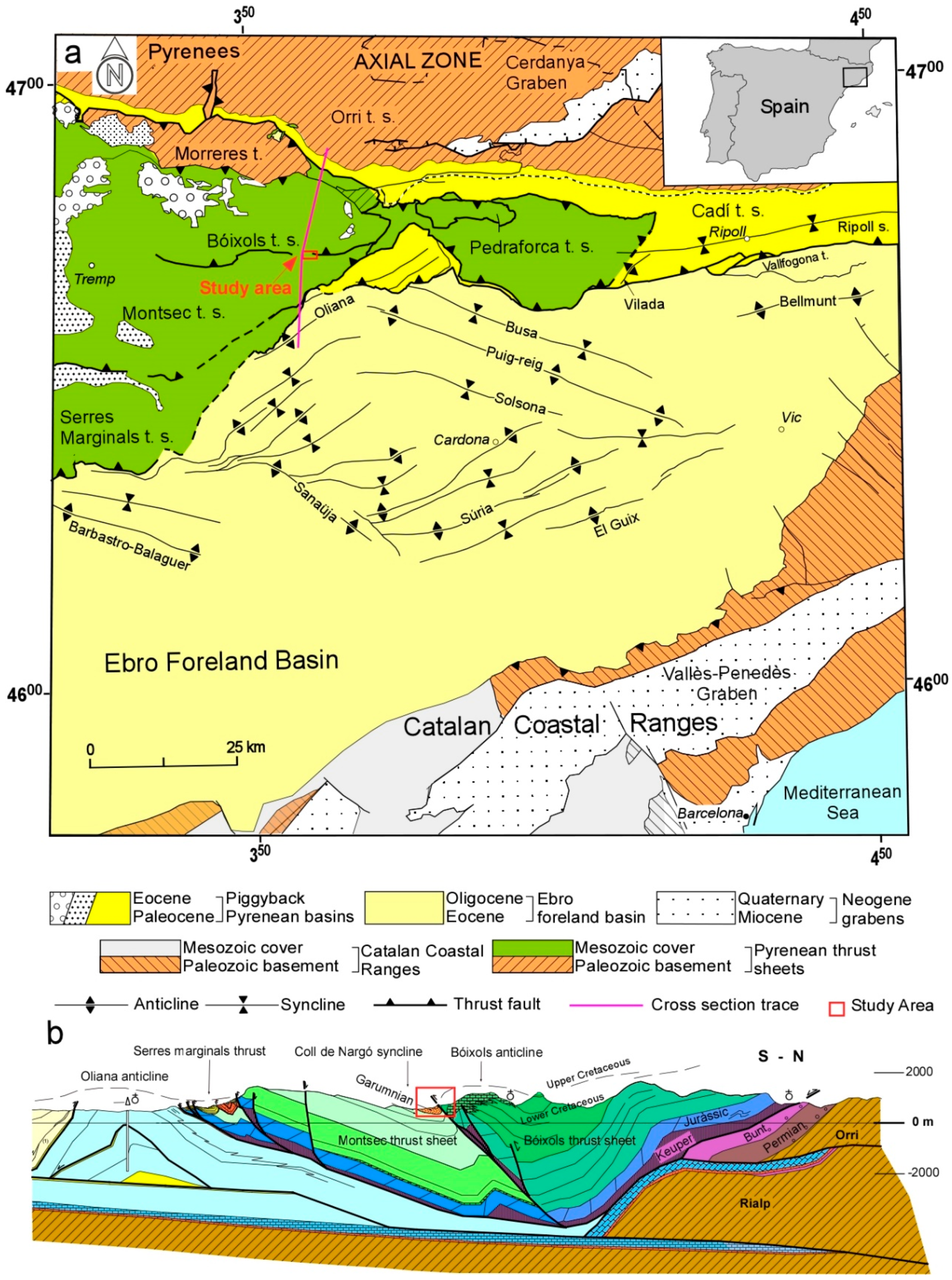
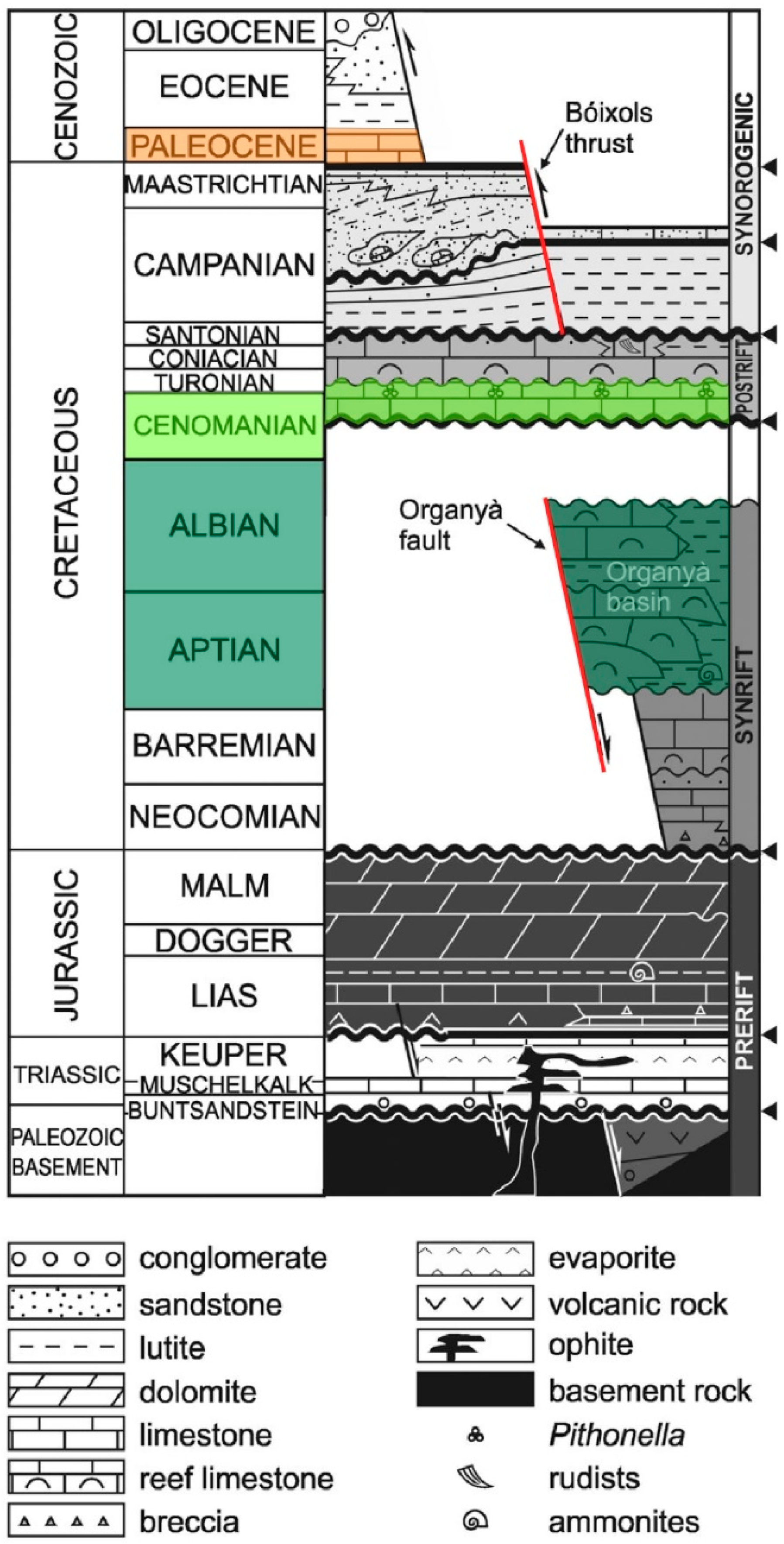
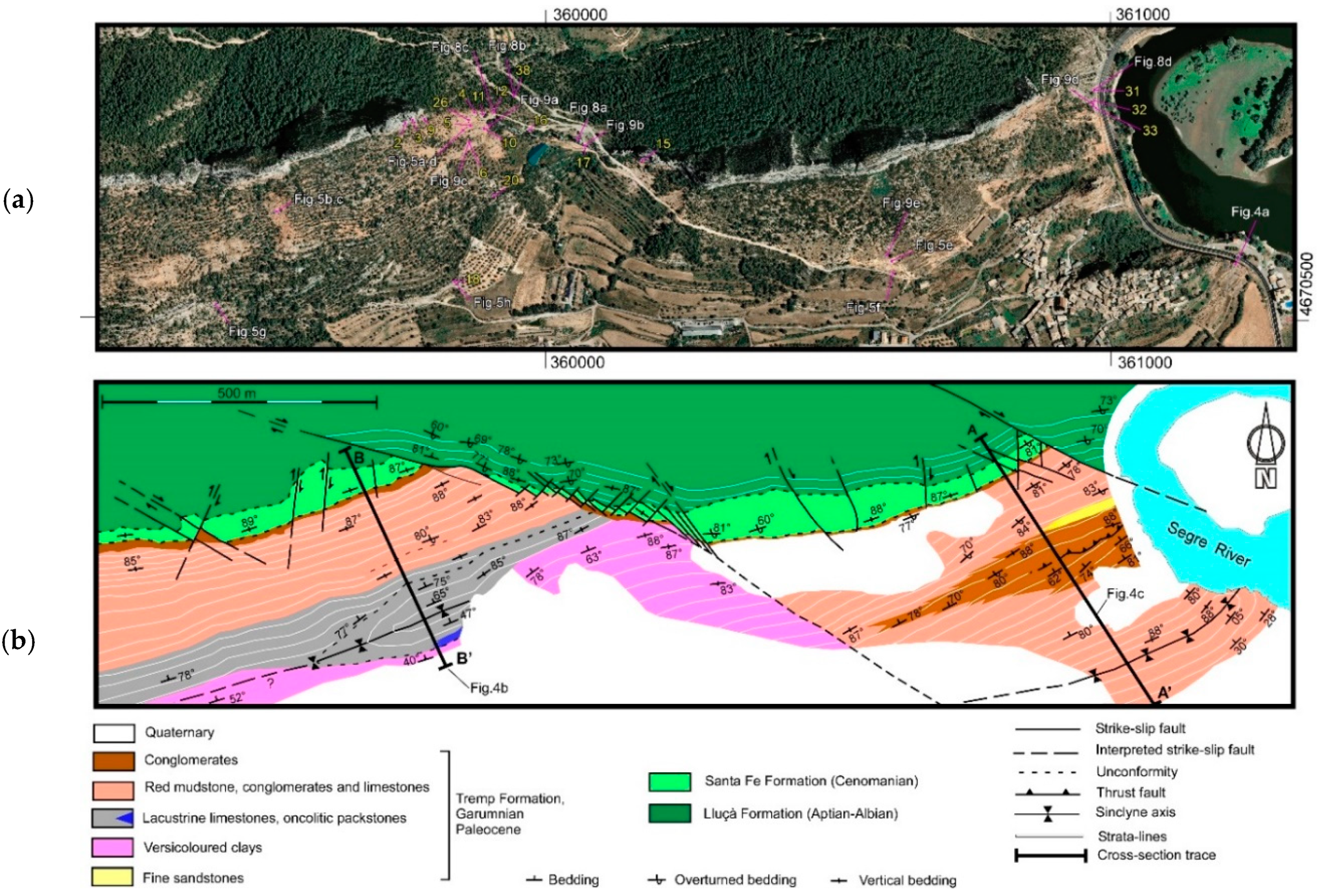
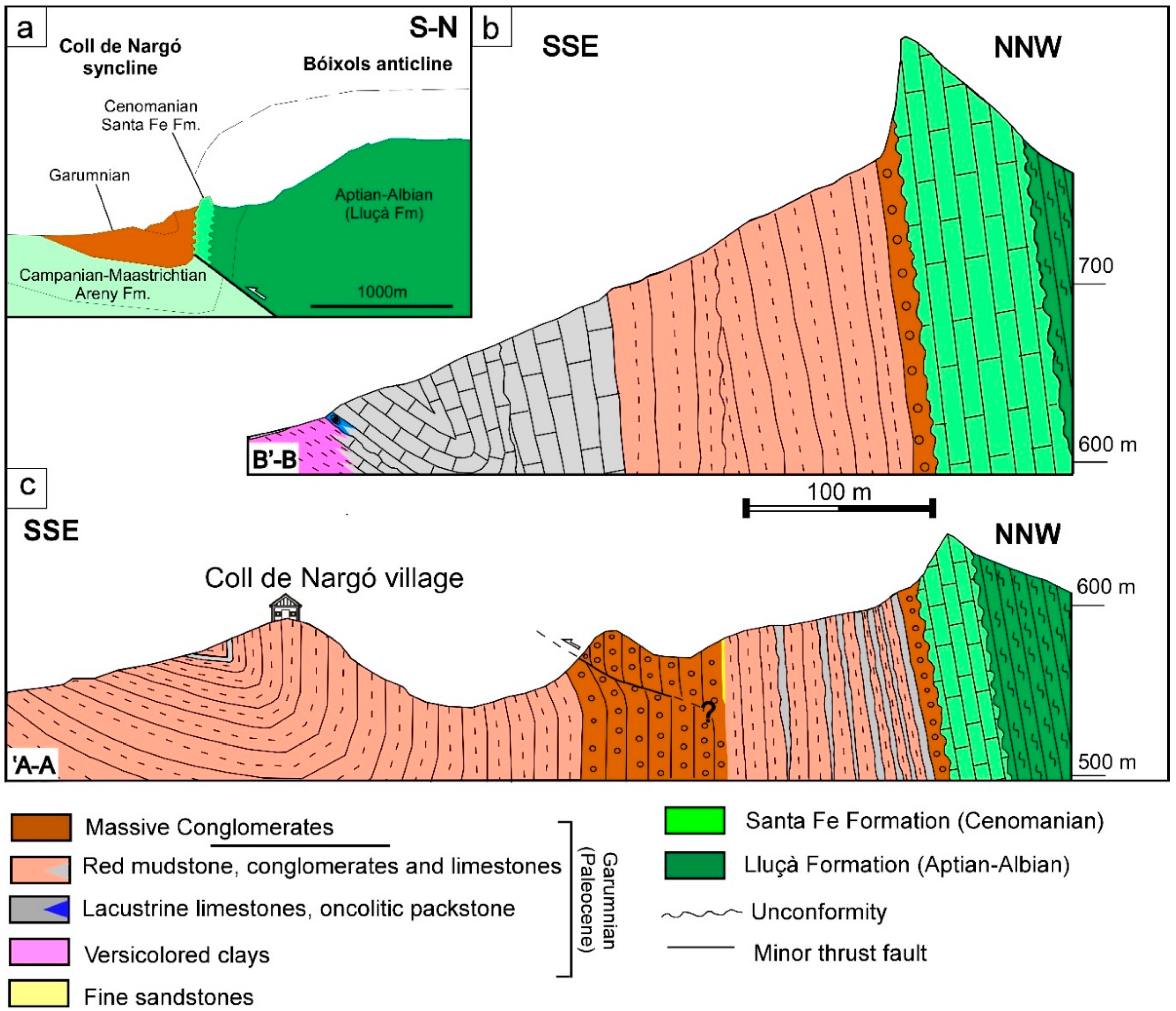
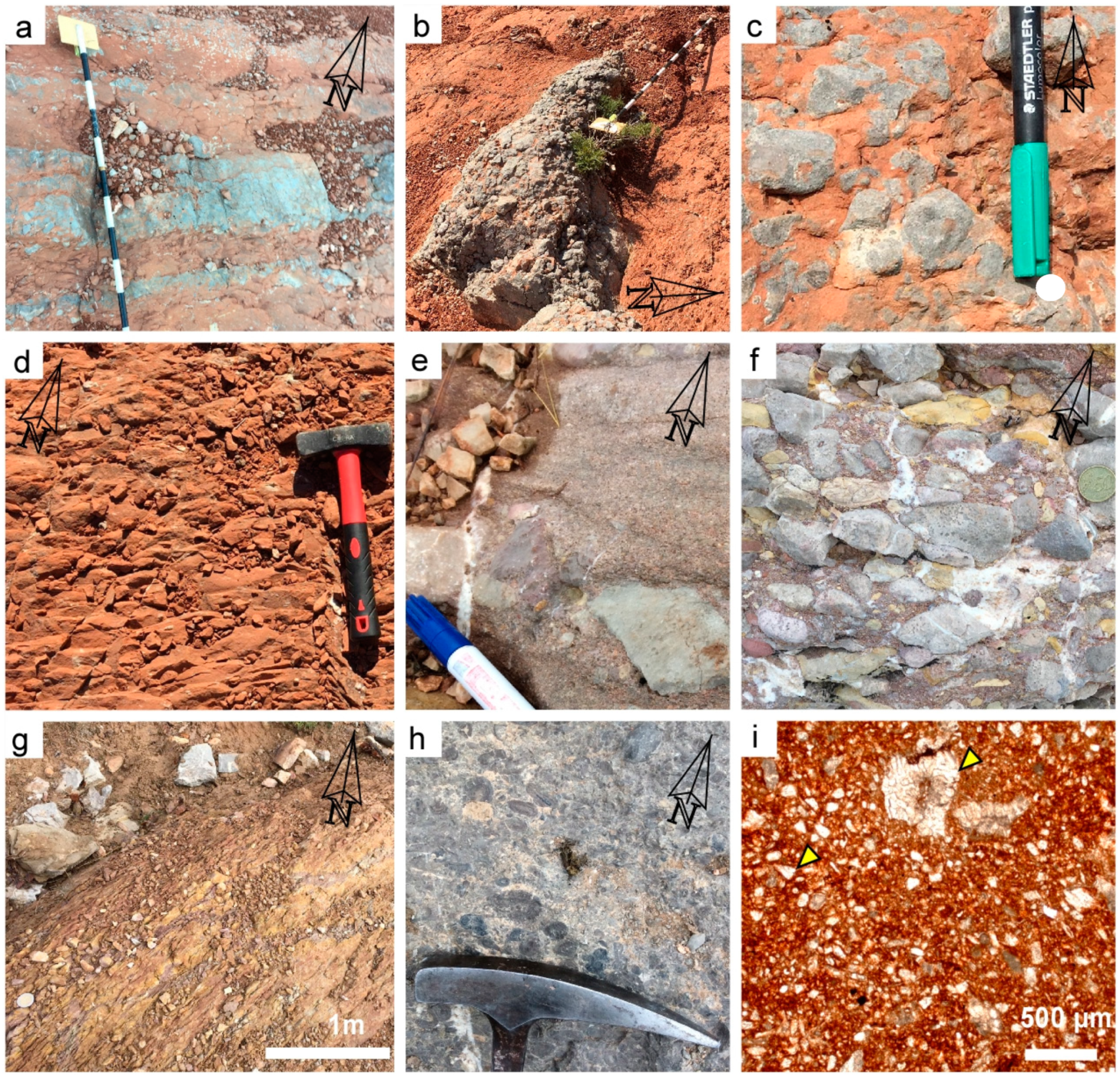
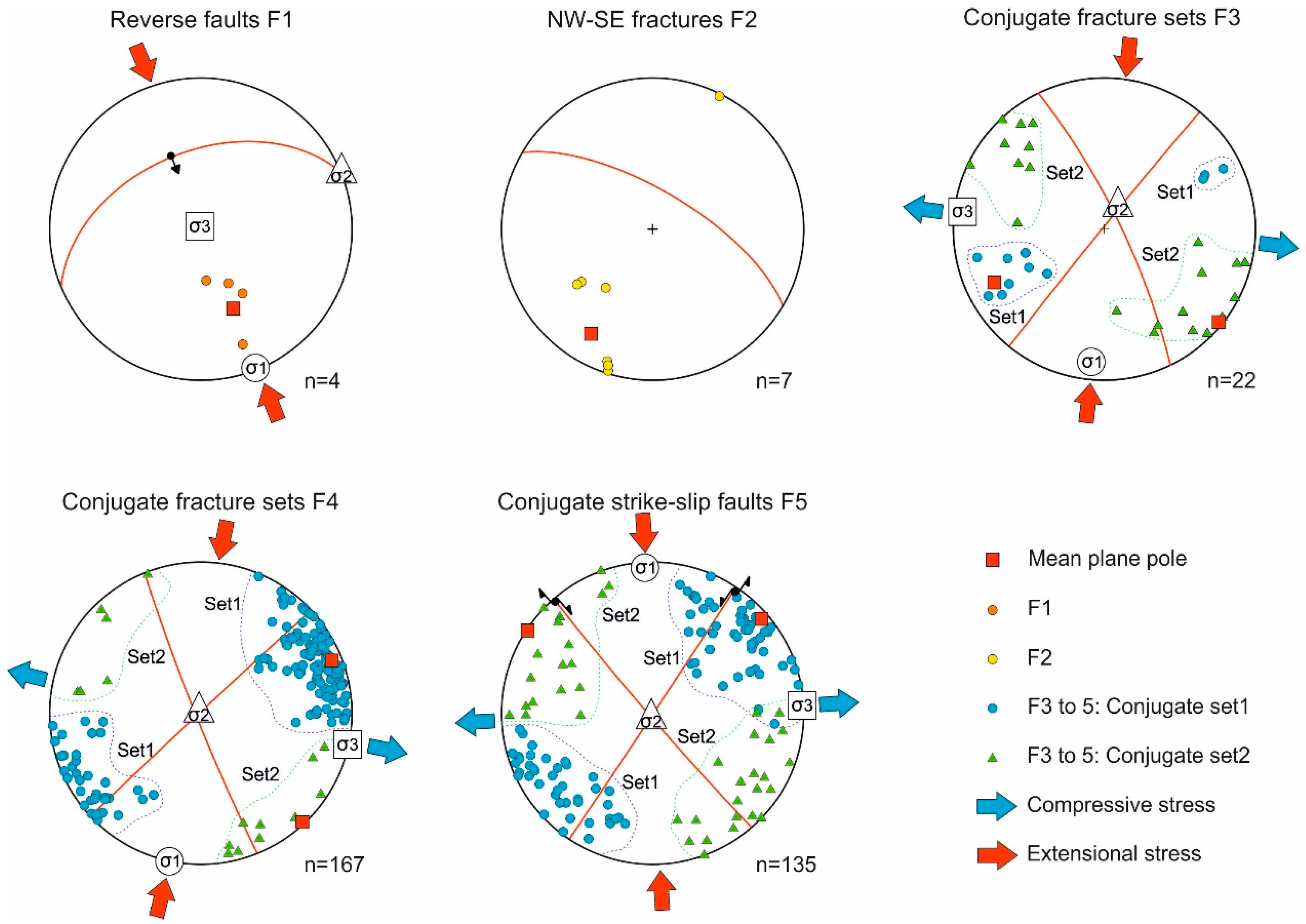
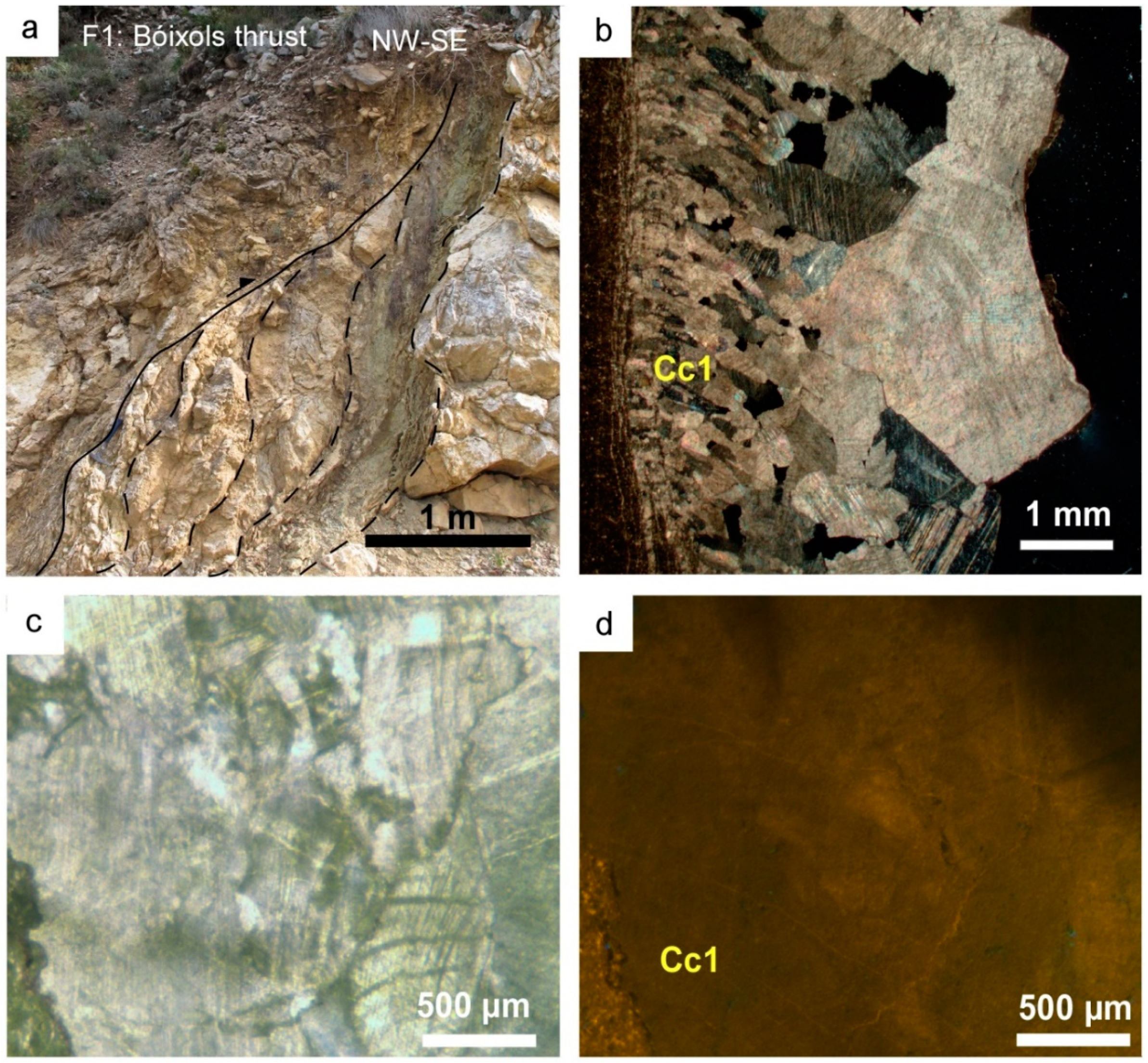
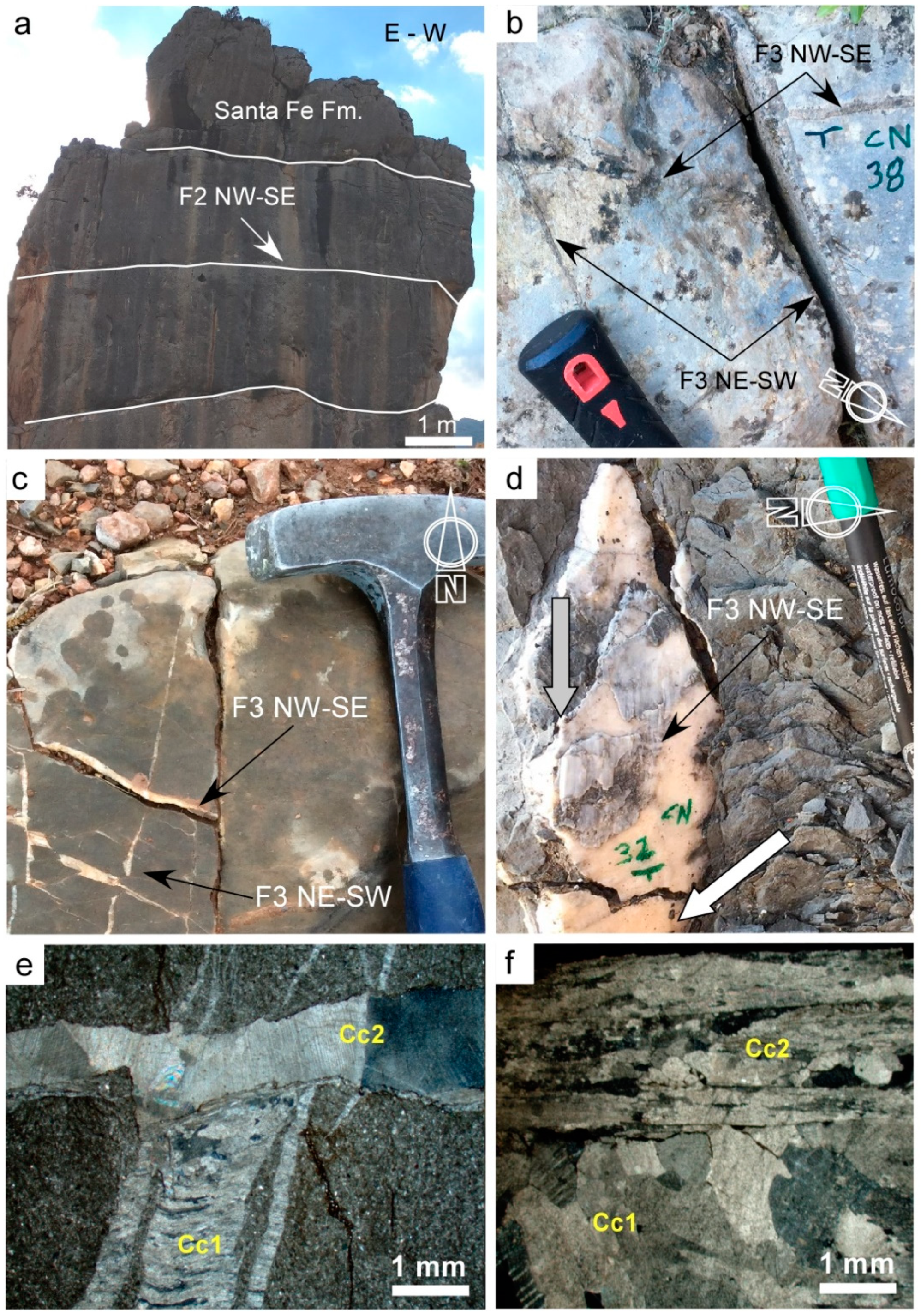
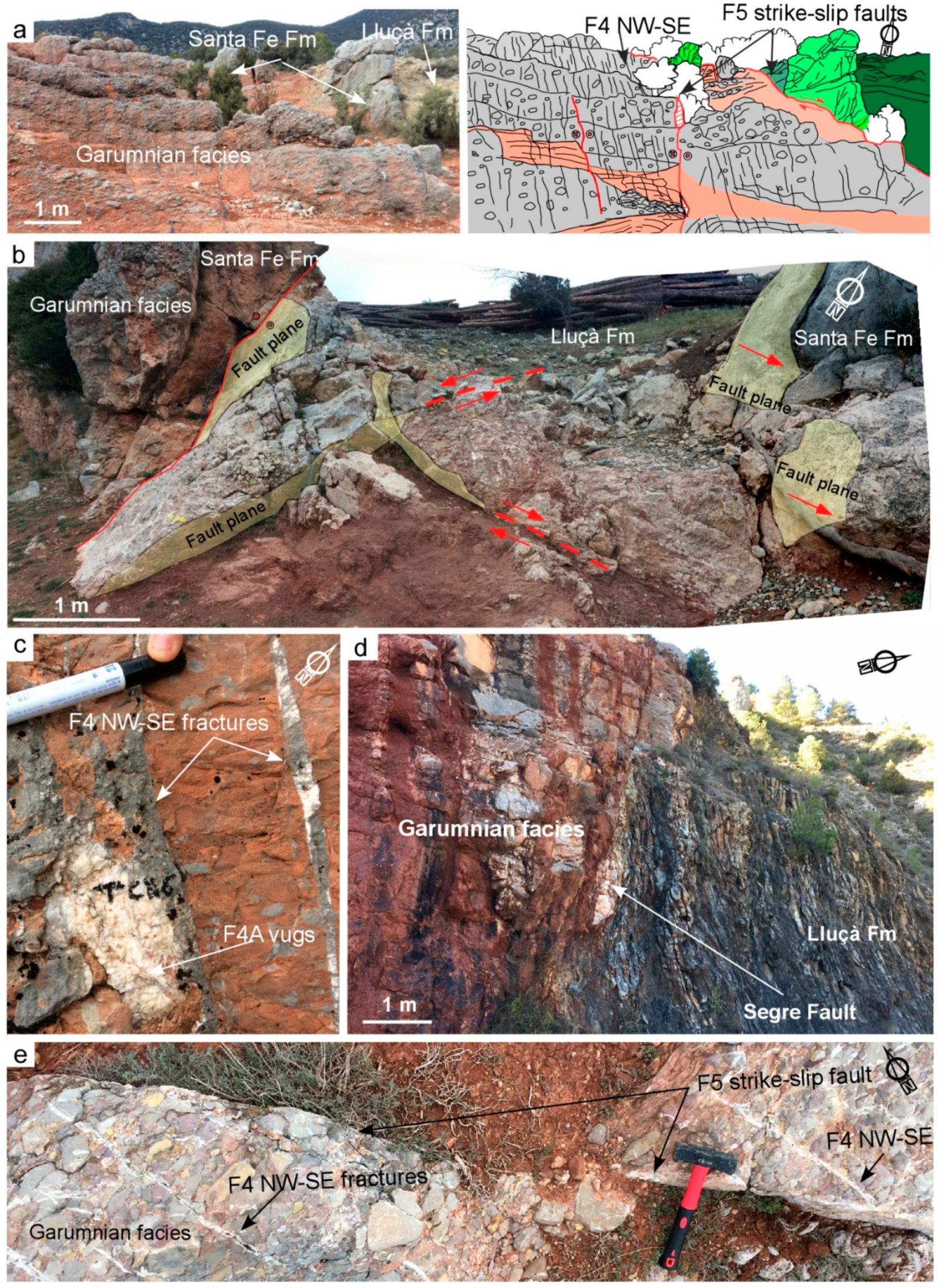
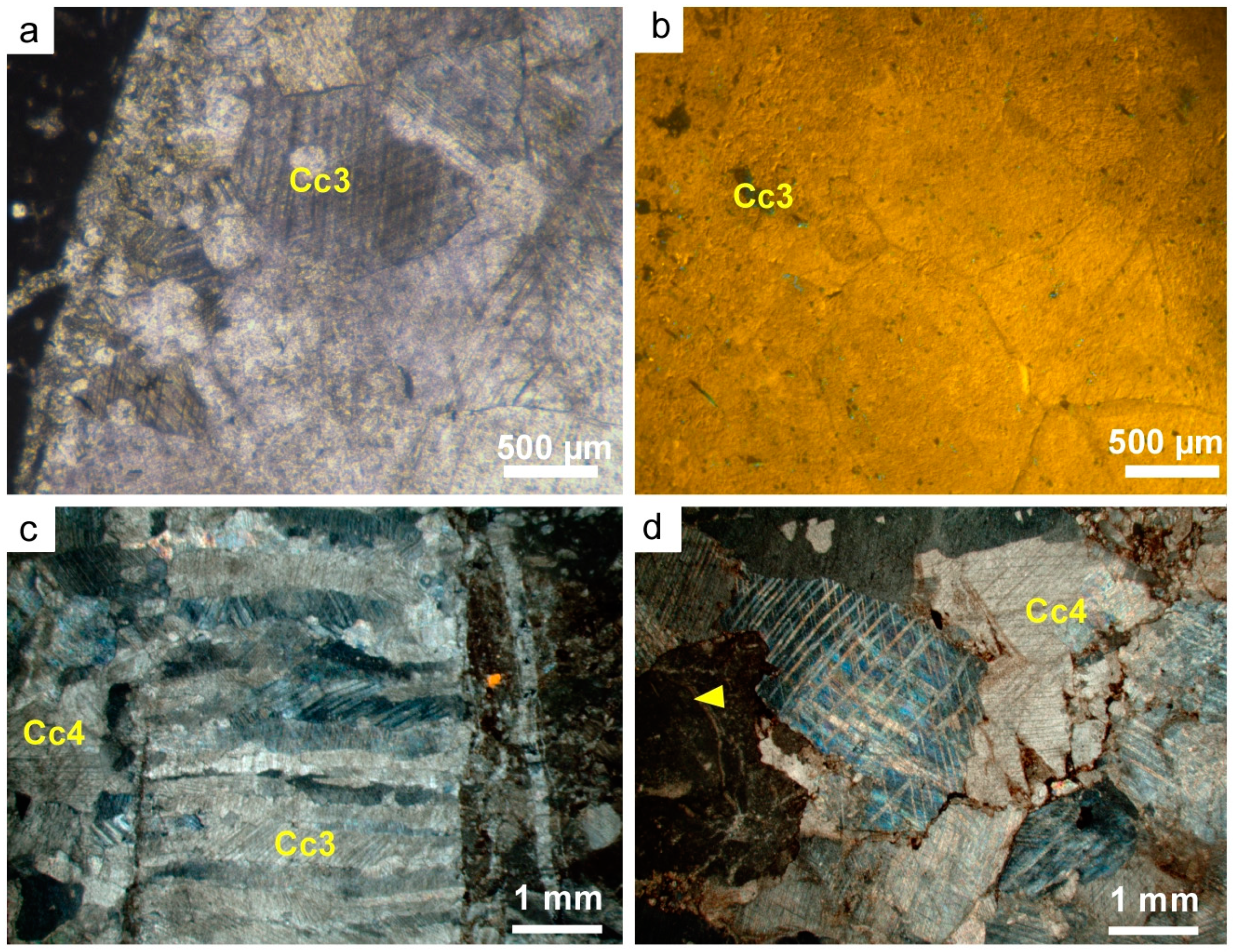
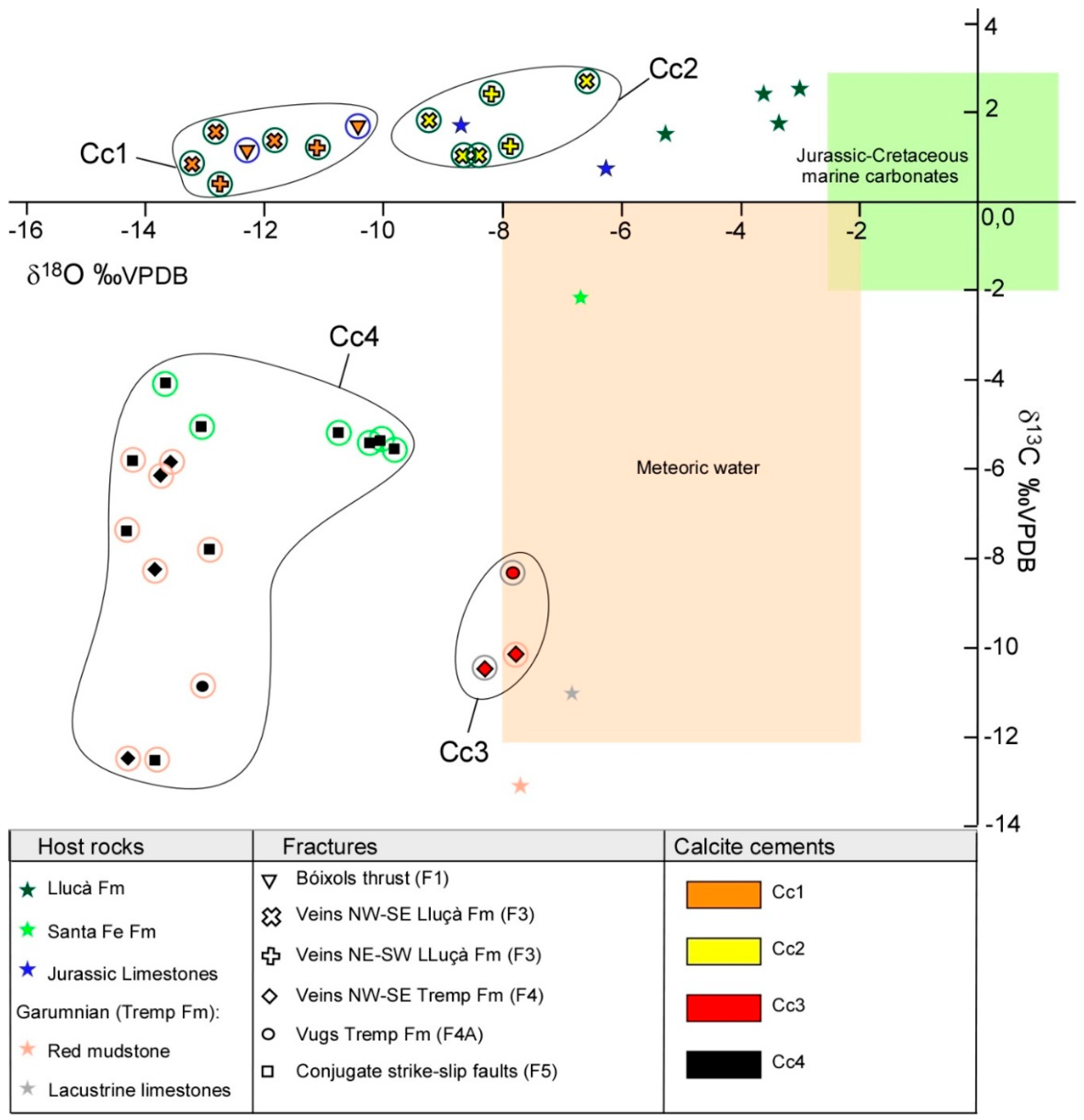
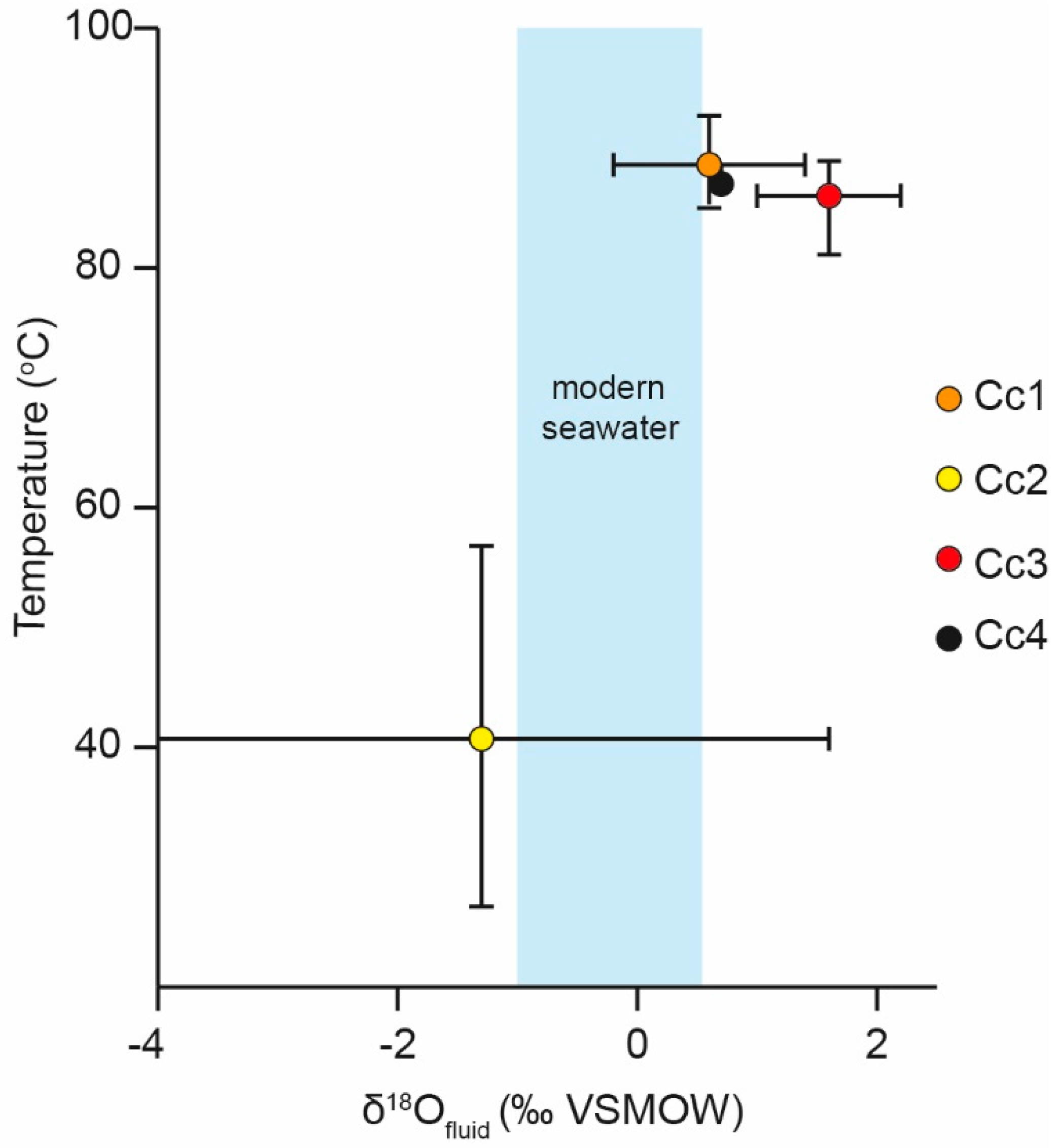
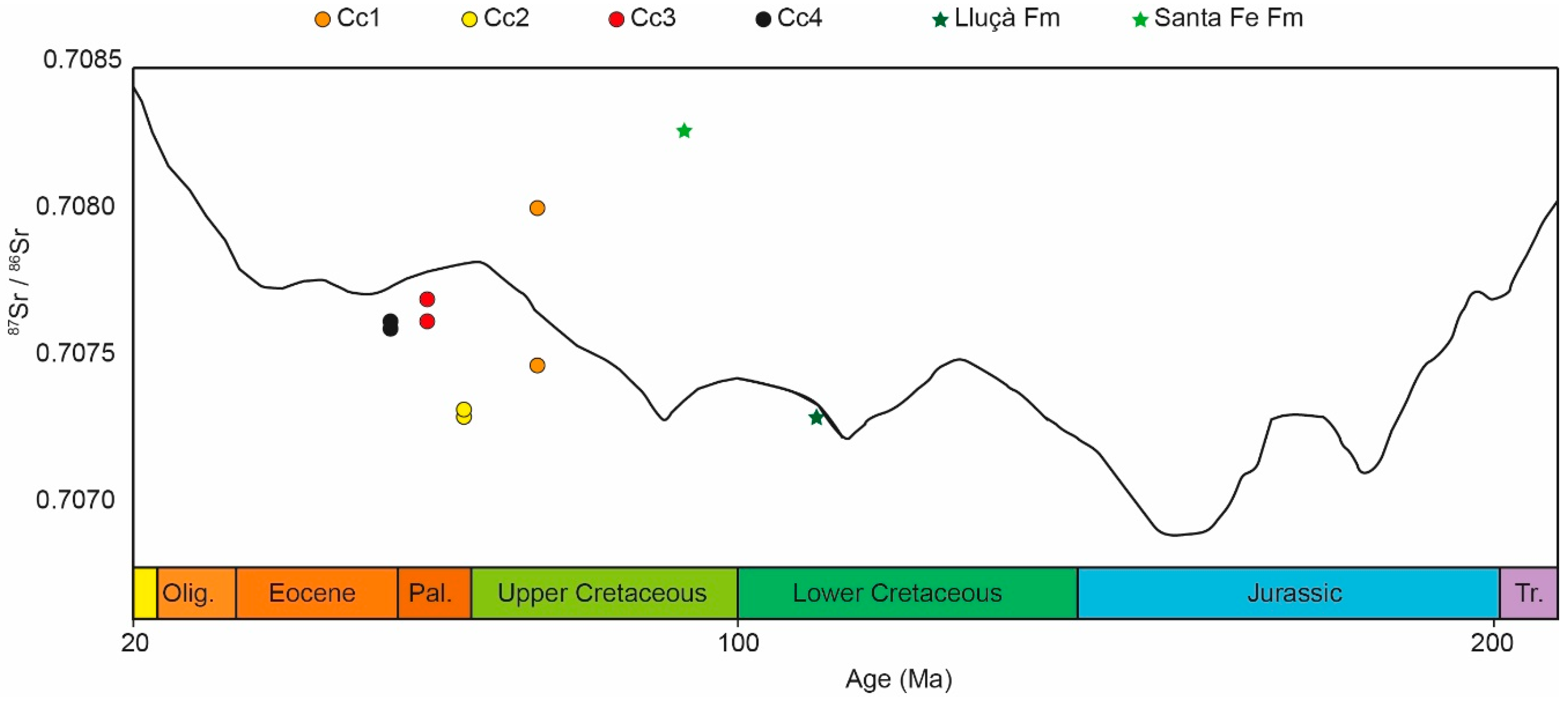
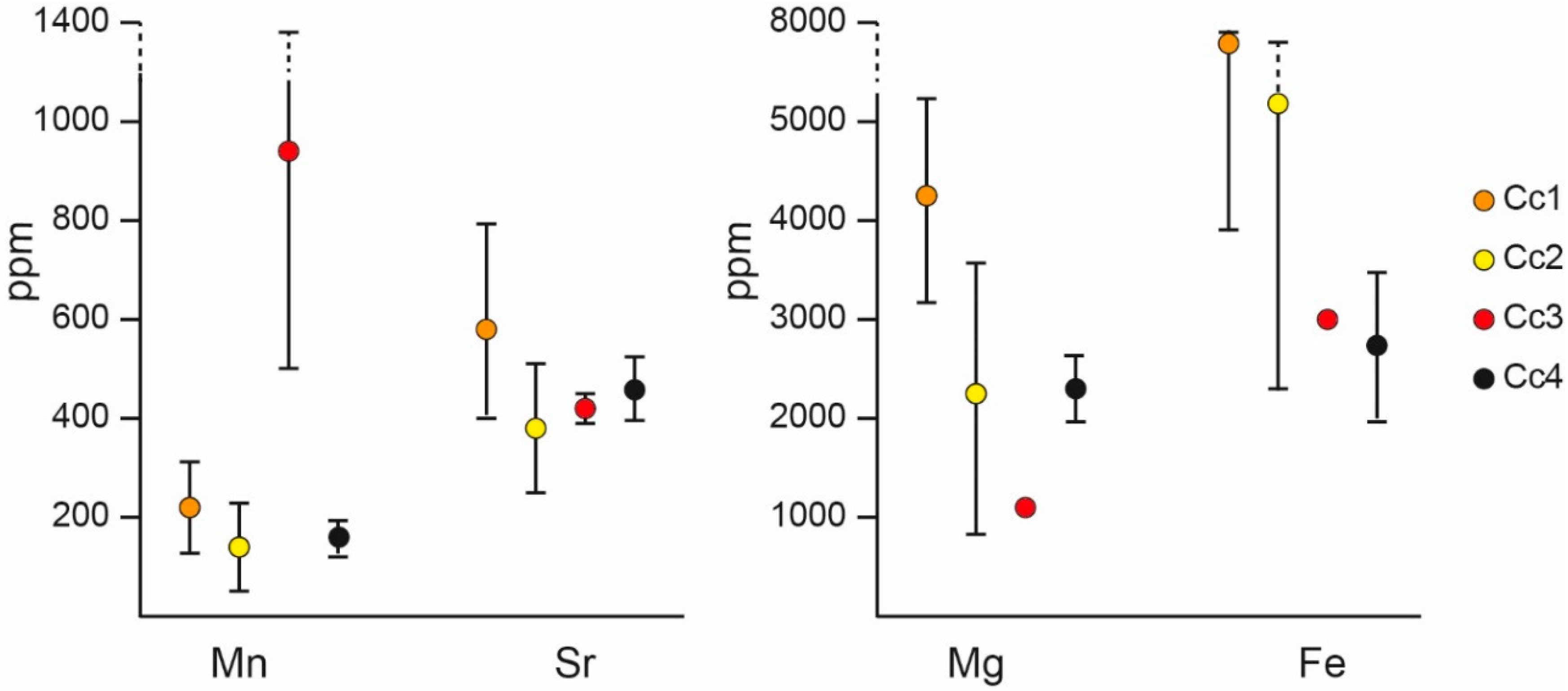
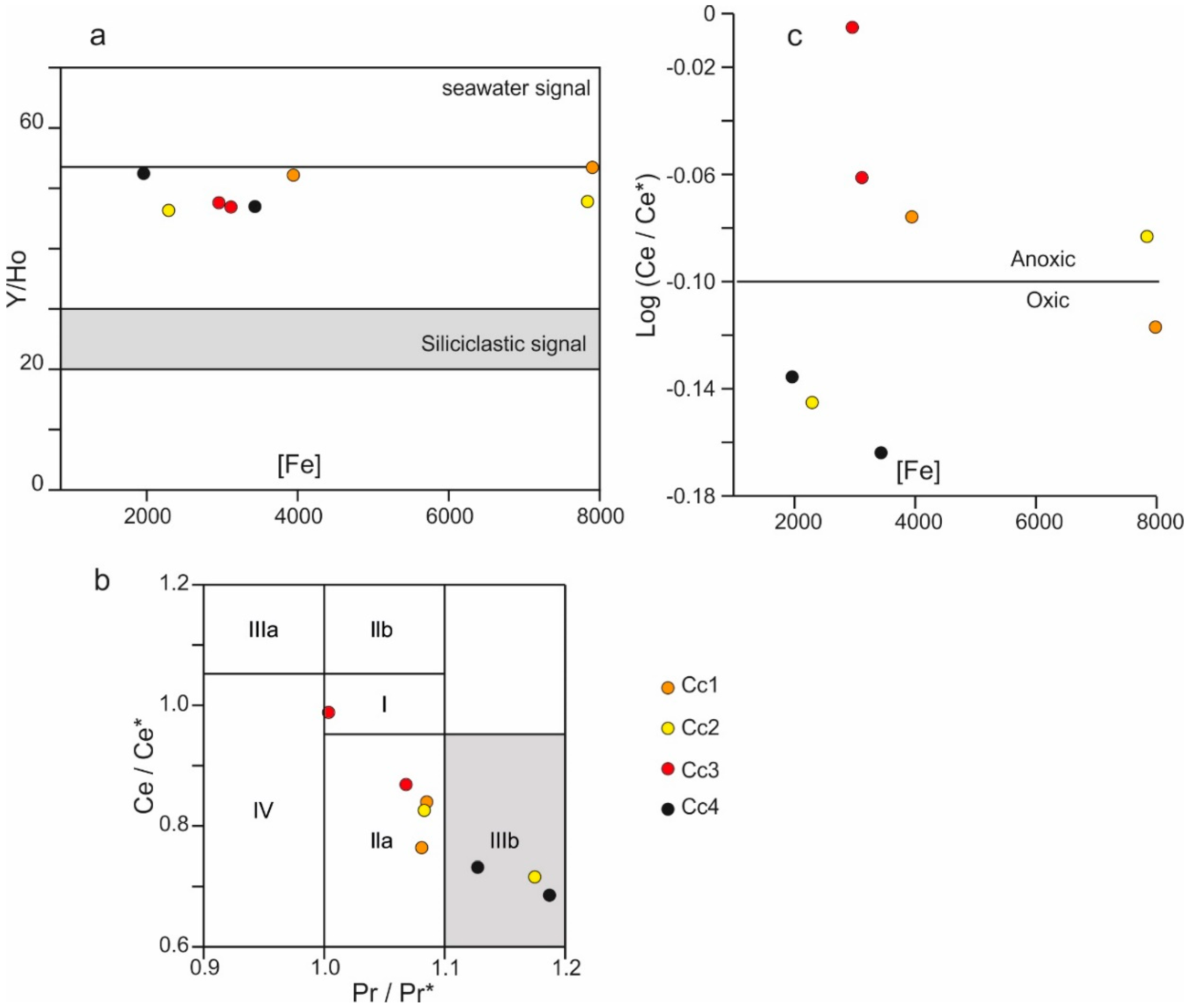
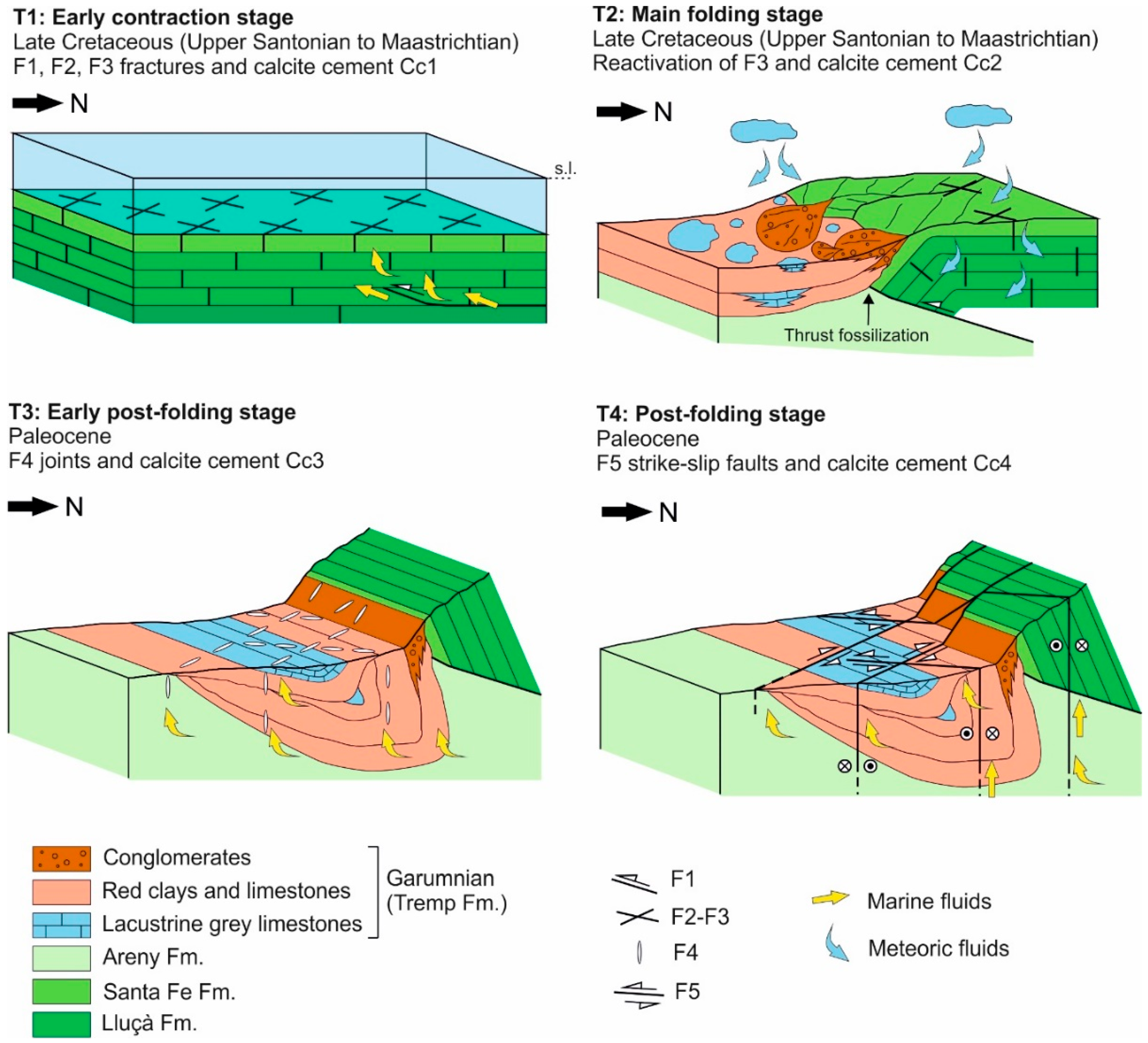
| Sample | Fracture Set | Cement | δ18O (‰ VPDB) | δ13C (‰ VPDB) |
|---|---|---|---|---|
| CN2A | F4 | Cc4 | −13.73 | −6.13 |
| CN3A | F5 sx | Cc4 | −14.21 | −5.81 |
| CN4A | F5 dx | Cc4 | −14.3 | −7.38 |
| CN4B | F5 dx | Cc4 | −12.93 | −7.78 |
| CN5A | F4 | Cc4 | −14.31 | −12.48 |
| CN5B | Garumnian mudstone | −7.67 | −13.06 | |
| CN6A | F4A | Cc4 | −13.02 | −10.85 |
| CN9A | F4 | Cc4 | −13.58 | −5.83 |
| CN10A | F5 dx | Cc4 | −13.85 | −12.51 |
| CN11A | F3 NW-SE | Cc1 | −12.77 | +1.58 |
| CN12A | F3 NE-SW | Cc2 | −7.87 | +1.25 |
| CN12B | F3 NW-SE | Cc1 | −11.83 | +1.34 |
| CN12C | Lluçà Fm | −3.31 | +1.76 | |
| CN15A-A | F5 sx | Cc4 | −10.06 | −5.38 |
| CN15A-B | F5 sx | Cc4 | −13.66 | −4.07 |
| CN15B-A | F5 sx | Cc4 | −10.88 | −5.76 |
| CN16A | F5 sx | Cc4 | −13.06 | −5.05 |
| CN16B | Santa Fe Fm | −6.65 | −2.14 | |
| CN16C | F5 sx | Cc4 | −9.86 | −5.51 |
| CN17A | F5 dx | Cc4 | −10.22 | −5.4 |
| CN18A | F4A | Cc3 | −7.82 | −8.3 |
| CN20A | F4 | Cc3 | −8.28 | −10.43 |
| CN20B | Garumnian limestone | −6.84 | −11.01 | |
| CN26A | F4 | Cc3 | −7.79 | −10.14 |
| CN26B | F4 | Cc4 | −13.84 | −8.22 |
| CN27A | F1 | Cc1 | −12.28 | +1.13 |
| CN27B | Jurassic limestone | −6.22 | +0.72 | |
| CN28A | F1 | Cc1 | −10.43 | +1.67 |
| CN28B | Jurassic limestone | −8.66 | +1.69 | |
| CN31A | Lluçà Fm | −3.62 | +2.4 | |
| CN31B | F3 NW-SE | Cc2 | −9.23 | +1.8 |
| CN32A | F3 NW-SE | Cc2 | −8.42 | +1.03 |
| CN32B | F3 NW-SE | Cc1 | −13.22 | +0.82 |
| CN32C | Lluçà Fm | −5.06 | +1.59 | |
| CN32D | F3 NW-SE | Cc2 | −8.64 | +1.04 |
| CN33A | F3 NE-SW | Cc1 | −11.09 | +1.19 |
| CN33B | F3 NE-SW | Cc1 | −12.71 | +0.37 |
| CN38A | F3 NW-SE | Cc2 | −6.59 | +2.7 |
| CN38B | F3 NE-SW | Cc2 | −8.19 | +2.41 |
| CN38C | Lluçà Fm | −3 | +2.51 |
| Sample | Fracture Set | Cements | n | δ18O (‰ VPDB) | δ13C (‰ VPDB) | Δ47 | T (°C) | δ18Ofluid (‰ VSMOW) |
|---|---|---|---|---|---|---|---|---|
| CN33 | F3 NE-SW | Cc1 | 2 | −12.39 | +0.77 | 0.542 ± 0.006 | 88.4 ± 3.8 | +0.6 ± 0.8 |
| CN38 | F3 NE-SW | Cc2 | 1 | −6.91 | +2.56 | 0.646 | 40.7 ± 16.1 | −1.3 ± 2.9 |
| CN20 | F4 | Cc3 | 2 | −11.04 | −10.3 | 0.548 ± 0.007 | 85.3 ± 4 | +1.6 ± 0.6 |
| CN15 | F5 | Cc4 | 2 | −12.18 | −4.38 | 0.544 ± 0.001 | 87.6 ± 0.6 | +0.7 ± 0.2 |
| Sample | Fracture Set | Cements | Mn | Sr | Mg | Fe | Y | Ce | Pr | Ho |
|---|---|---|---|---|---|---|---|---|---|---|
| CN27 | F1 | Cc1 | 135 | 409 | 5280 | 3943 | 2.4 | 3.6 | 0.5 | 0.05 |
| CN33 | F3 NE-SW | Cc1 | 320 | 795 | 3218 | 7981 | 7 | 3.9 | 0.7 | 0.1 |
| CN38 | F3 NE-SW | Cc2 | 47 | 241 | 873 | 2291 | 0.7 | 0.4 | 0.05 | 0.02 |
| CN12 | F3 NE-SW | Cc2 | 225 | 501 | 3613 | 7840 | 6.1 | 4.2 | 0.6 | 0.1 |
| CN20 | F4 | Cc3 | 501 | 389 | 1080 | 2956 | 0.7 | 0.7 | 0.1 | 0.01 |
| CN18 | F4 | Cc3 | 1380 | 450 | 1084 | 3116 | 1.1 | 1.6 | 0.2 | 0.02 |
| CN6 | F4 | Cc4 | 186 | 391 | 2621 | 3433 | 5.8 | 6.8 | 1.1 | 0.1 |
| CN15 | F5 sx | Cc4 | 119 | 520 | 1956 | 1986 | 2.8 | 2.4 | 0.4 | 0.05 |
© 2019 by the authors. Licensee MDPI, Basel, Switzerland. This article is an open access article distributed under the terms and conditions of the Creative Commons Attribution (CC BY) license (http://creativecommons.org/licenses/by/4.0/).
Share and Cite
Nardini, N.; Muñoz-López, D.; Cruset, D.; Cantarero, I.; Martín-Martín, J.D.; Benedicto, A.; Gomez-Rivas, E.; John, C.M.; Travé, A. From Early Contraction to Post-Folding Fluid Evolution in the Frontal Part of the Bóixols Thrust Sheet (Southern Pyrenees) as Revealed by the Texture and Geochemistry of Calcite Cements. Minerals 2019, 9, 117. https://doi.org/10.3390/min9020117
Nardini N, Muñoz-López D, Cruset D, Cantarero I, Martín-Martín JD, Benedicto A, Gomez-Rivas E, John CM, Travé A. From Early Contraction to Post-Folding Fluid Evolution in the Frontal Part of the Bóixols Thrust Sheet (Southern Pyrenees) as Revealed by the Texture and Geochemistry of Calcite Cements. Minerals. 2019; 9(2):117. https://doi.org/10.3390/min9020117
Chicago/Turabian StyleNardini, Nicholas, Daniel Muñoz-López, David Cruset, Irene Cantarero, Juan Diego Martín-Martín, Antonio Benedicto, Enrique Gomez-Rivas, Cédric M. John, and Anna Travé. 2019. "From Early Contraction to Post-Folding Fluid Evolution in the Frontal Part of the Bóixols Thrust Sheet (Southern Pyrenees) as Revealed by the Texture and Geochemistry of Calcite Cements" Minerals 9, no. 2: 117. https://doi.org/10.3390/min9020117
APA StyleNardini, N., Muñoz-López, D., Cruset, D., Cantarero, I., Martín-Martín, J. D., Benedicto, A., Gomez-Rivas, E., John, C. M., & Travé, A. (2019). From Early Contraction to Post-Folding Fluid Evolution in the Frontal Part of the Bóixols Thrust Sheet (Southern Pyrenees) as Revealed by the Texture and Geochemistry of Calcite Cements. Minerals, 9(2), 117. https://doi.org/10.3390/min9020117







